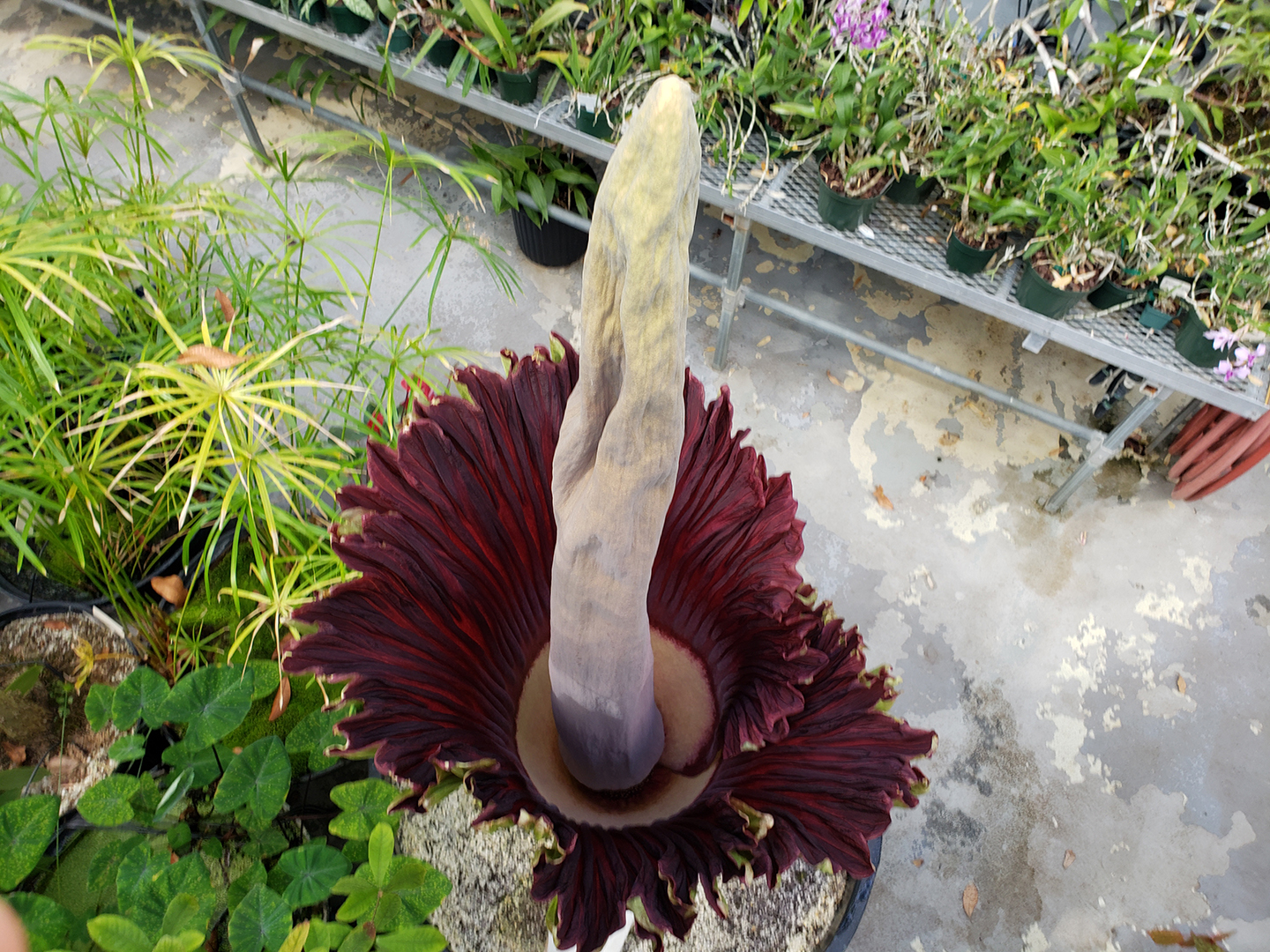Sexy, stinky corpse plant blooms to life on livestream (watch here)
Streaming video offers a stink-free view of the notoriously malodorous plant
Who wants to see a plant that's as tall as a person and reeks of decaying flesh? (Aside from everyone in the Live Science newsroom, that is.)
Amorphophallus titanum, also known as the "corpse plant" for its eye-watering aroma, is native to Sumatra. But one is blooming right now in New York City at Barnard College's Arthur Ross Greenhouse, for the first time in a decade.
There are few greenhouse visitors these days, due to the COVID-19 pandemic. But even if you're socially distancing or live far away from NYC, you can still catch a glimpse of the smelly blossom (and avoid its powerful stink) by tuning in to the greenhouse's livestream right here. The stream launched on May 27 after the corpse plant began to bloom.
Related: Photos: Stinky 'corpse flower' blooms
This particular A. titanum arrived at the Barnard greenhouse seven years ago, a gift from the Brooklyn Botanical Garden. At the time, it was a tuberous bulb that weighed about 1 lb. (0.5 kilograms) and was the size of a large potato. Under the care of greenhouse horticulturist Nicholas Gershberg, the Barnard corpse plant now weighs more than 40 lbs. (18 kg) and sports a flower standing over 5 feet (1.5 meters) tall, said greenhouse director Hilary Callahan, a professor of biological sciences at Barnard.
The plant began to bloom in April, with a leaf-wrapped cylindrical stalk poking straight up from the center, and grew to its current height in about two months, Callahan told Live Science. "Then it dramatically opened up like a pleated cloak, or a collar of a fancy blouse," Callahan said. "We joked that it looks like a costume Billy Porter would wear on the red carpet."
It takes about seven to 10 years for a corpse plant to generate its first bloom, depending on the availability of resources like sunlight and water from year to year, Callahan said. As a growing juvenile, a corpse plant produces one enormous leaf annually, which withers and dies after a few months. But even after the leaf is gone, the tuber underground continues to process nutrients and grow. It sends another green shoot up into the sunlight the following year, and the cycle repeats until the plant becomes sexually mature and is ready to flower — though the process that sends that signal is still not well understood, Callahan said.
Get the world’s most fascinating discoveries delivered straight to your inbox.

As the bloom's fabulous "costume" unfurled on Sunday (May 31), it unleashed the pungent, trademark odor that earned it the name "corpse plant." The distinctive smell lingers for just a few days, and though Callahan described the scent as "funky" and "very complex," she added that it was not necessarily offensive or unpleasant.
"It's like a mature cheese," she said. "Or the feet of someone that you really like."
The corpse plant's aroma will be gone soon, but the bloom will linger for several more weeks; once it starts to wither, Gershberg will attempt to dry the blossom intact, to preserve it as a specimen for display or study. The tuberous part of the plant that's beneath the ground will be dug up, cleaned, inspected and repotted. And if conditions are favorable, it just may bloom again within a few years, Callahan said.
- Flower photos: Beautiful begonias
- In photos: Beautiful cactus flowers signal spring is here
- In images: Stunning flower fields of the Atacama Desert
Originally published on Live Science.
OFFER: Save 45% on 'How It Works' 'All About Space' and 'All About History'!
For a limited time, you can take out a digital subscription to any of our best-selling science magazines for just $2.38 per month, or 45% off the standard price for the first three months.

Mindy Weisberger is a science journalist and author of "Rise of the Zombie Bugs: The Surprising Science of Parasitic Mind-Control" (Hopkins Press). She formerly edited for Scholastic and was a channel editor and senior writer for Live Science. She has reported on general science, covering climate change, paleontology, biology and space. Mindy studied film at Columbia University; prior to LS, she produced, wrote and directed media for the American Museum of Natural History in NYC. Her videos about dinosaurs, astrophysics, biodiversity and evolution appear in museums and science centers worldwide, earning awards such as the CINE Golden Eagle and the Communicator Award of Excellence. Her writing has also appeared in Scientific American, The Washington Post, How It Works Magazine and CNN.




